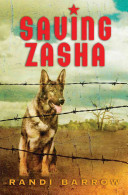
Saving Zasha
Written by Randi Barrow
Scholastic, 2011, 229 pp.
ISBN: 978-0545206327
This suspense-filled novel is set in post-World War II Russia with a plot that revolves around a family hiding and training a German shepherd dog. Devastated by Germany in WWII, anything German is hated in Russia, and so when Mikhail comes across a dying man and his dog, he believes that the dog will be killed if its presence becomes known in their rural community. The family’s willingness to care for the pregnant dog despite the danger of being labeled traitors is set within the larger context of their struggle to survive and their search for Mikhail’s father who is missing in action. Other elements of the plot include a secret Russian program to breed a super dog, a classmate who spies on Mikhail, and canine thieves who steal dogs because of their scarcity after the war. The book is a page-turner with each new threat heightening the sense of danger. A historical note about the experiment to breed the Black Russian terrier is included.
Many readers will be drawn to this book as animal-lovers and because of the engaging suspense. Teachers will find the book of interest because so little is available for children about the aftermath of WWII in Russia. Reviews of the book are positive, calling it an engaging and hopeful animal story with a strong sense of time and place that provides readers with details and background information about 20th century Russian life and history. The one critique is that character development is sometimes sacrificed to action.
Because I was working with an educator from Russia, Sasha Kuchuk, on a project to create a Russian language and culture book kit, this book seemed like a perfect fit to engage kids through a dog story while also sneaking in Russian culture and history. Sasha’s response was a strong sense of violation as a Russian due to inaccuracies and a lack of authenticity in the book. While the author was inspired by events that did occur in Russia, such as the super dog breeding program and the use of dogs on battlefields, Sasha felt that the author used Russia merely as a convenient setting for her message and story. The author’s note indicates research on dogs and warfare, but this same research was not extended to a realistic representation of Russian life and culture. For example, Sasha pointed out that the lifestyle of the characters bears little resemblance to actual life in Russia after WWII. The family lives in their own farm house on their own farm land, but there was no such thing as private property in Russia during that time period. Having a newspaper published in a remote northern village at that time is another detail that is highly unlikely. Sasha indicated that the author did not understand how people lived in villages, the tremendous suffering in Russia after WWII, and the degree to which people’s lives were in shambles. She also pointed out that while the threat of killing German shepherd dogs may have occurred, that was not a widespread sentiment or problem. The biggest issue for Sasha was the lack of authentic Russian setting to the point that she would not have recognized the book as Russian without the author’s label. The one aspect of the book that does appear Russian is the use of Russian names, but those seem to have been selected from a list of first and last names without research on patronymic names and how Russians actually address each other.
This book represents the problems that ensue when an author with a compelling story chooses a setting that fits the theme but then fails to research and understand the culture and setting. In this case, the setting is a backdrop for the author’s message. Given the small number of books available for children with a Russian setting, the misinformation and lack of an authentic Russian context makes this book highly problematic, particularly since the book is represented as historical fiction. Also of concern is the lack of research by mainstream review journals, none of which note the major inaccuracies within the book. The author’s web site indicates that Randi Barrow is an adoption attorney from California, but does not provide any information on her research or sources for the book related to Russian culture.
Few novels for teens and children on historical or contemporary Russia are currently in print in the U.S. One highly recommended book is Breaking Stalin’s Nose (Eugene Yelchin, 2011), a recent award-winning novel that is well written and historically accurate about a dark period in Russian history when Stalin created a culture of fear and oppression. The problem is that there are not contemporary novels that provide more positive depictions of current life in Russia to balance the darkness and fear of this book. One book can never reflect the range of experiences within any culture. The lack of books with strong contemporary or historical representations creates the context for misperceptions and stereotypes and perpetuates a lack of understanding and knowledge about Russian life and culture.
Kathy G. Short, University of Arizona
WOW Review, Volume IV, Issue 3 by Worlds of Words is licensed under a Creative Commons Attribution-NonCommercial-ShareAlike 4.0 International License. Based on work at https://wowlit.org/on-line-publications/review/iv-3/

Deborah,
I appreciate that you bring your knowledge and experiences in Haiti to bear as you commented on the language Nick Lake uses and the accuracy of the historical figures he references.
I started the book after hearing Lake speak at ALA Midwinter in January – but the story was just too dark for me at the time. Perhaps, after reading your review, I will pick it up again.
Thank you for your insights.